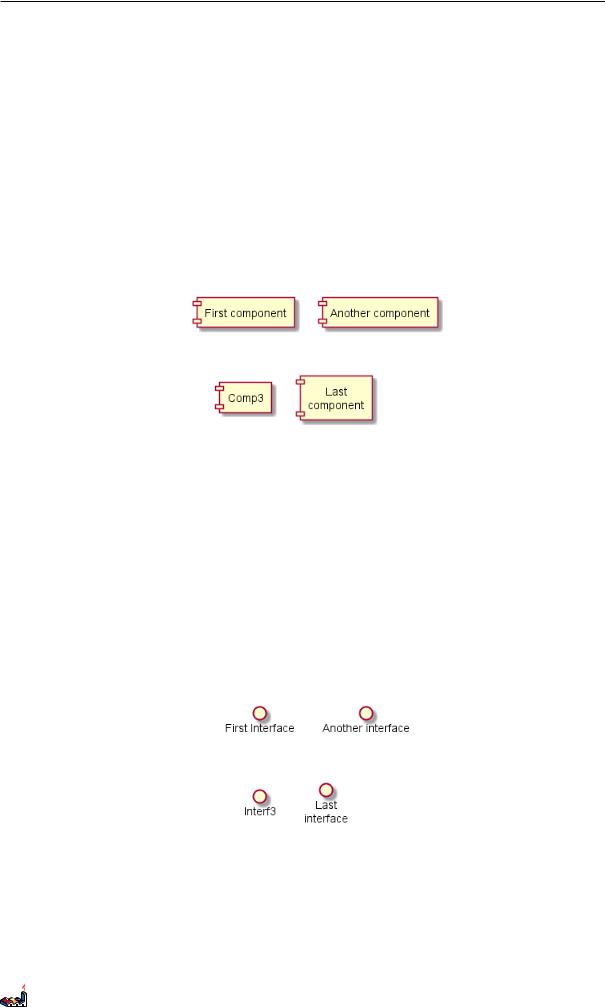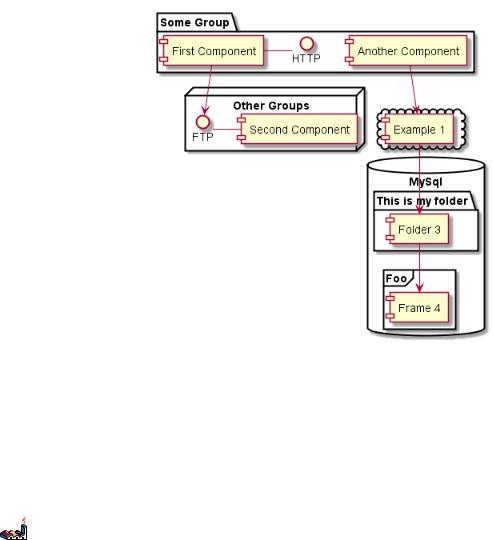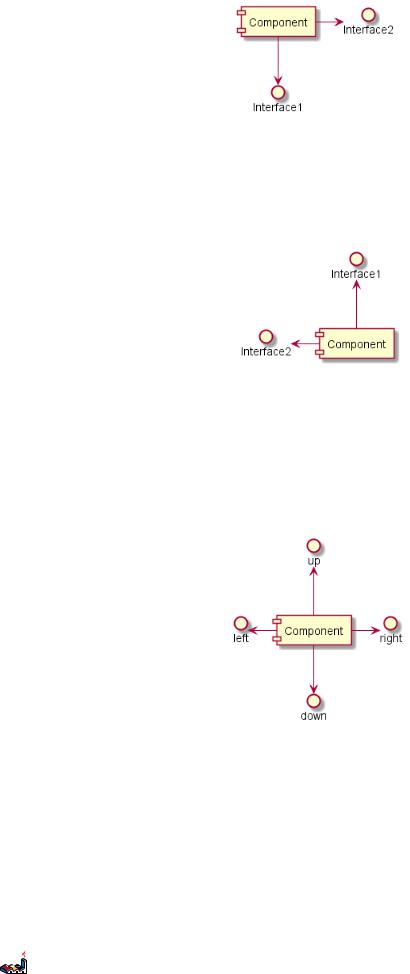
- •Sequence Diagram
- •Basic examples
- •Comments
- •Declaring participant
- •Use non-letters in participants
- •Message to Self
- •Change arrow style
- •Change arrow color
- •Message sequence numbering
- •Title
- •Legend the diagram
- •Splitting diagrams
- •Grouping message
- •Notes on messages
- •Some other notes
- •Changing notes shape
- •Creole and HTML
- •Divider
- •Reference
- •Delay
- •Space
- •Lifeline Activation and Destruction
- •Participant creation
- •Incoming and outgoing messages
- •Stereotypes and Spots
- •More information on titles
- •Participants encompass
- •Removing Footer
- •Skinparam
- •Use Case Diagram
- •Usecases
- •Actors
- •Usecases description
- •Basic example
- •Extension
- •Using notes
- •Stereotypes
- •Changing arrows direction
- •Title the diagram
- •Splitting diagrams
- •Left to right direction
- •Skinparam
- •Complete example
- •Class Diagram
- •Relations between classes
- •Label on relations
- •Adding methods
- •Abstract and Static
- •Advanced class body
- •Notes and stereotypes
- •More on notes
- •Note on links
- •Abstract class and interface
- •Using non-letters
- •Hide attributes, methods...
- •Hide classes
- •Use generics
- •Packages
- •Packages style
- •Namespaces
- •Automatic namespace creation
- •Lollipop interface
- •Changing arrows direction
- •Title the diagram
- •Legend the diagram
- •Association classes
- •Skinparam
- •Skinned Stereotypes
- •Color gradient
- •Activity Diagram
- •Simple Activity
- •Label on arrows
- •Changing arrow direction
- •Branches
- •More on Branches
- •Synchronization
- •Long activity description
- •Notes
- •Partition
- •Title the diagram
- •Skinparam
- •Octagon
- •Complete example
- •Activity Diagram (beta)
- •Simple Activity
- •Start/Stop
- •Conditional
- •Repeat loop
- •While loop
- •Parallel processing
- •Notes
- •Title Legend
- •Colors
- •Arrows
- •Grouping
- •Swimlanes
- •Detach
- •Complete example
- •Component Diagram
- •Components
- •Interfaces
- •Basic example
- •Using notes
- •Grouping Components
- •Changing arrows direction
- •Title the diagram
- •Use UML2 notation
- •Skinparam
- •State Diagram
- •Simple State
- •Composite state
- •Long name
- •Concurrent state
- •Arrow direction
- •Note
- •More in notes
- •Skinparam
- •Object Diagram
- •Relations between objects
- •Common features with class diagrams
- •Common commands
- •Footer and header
- •Zoom
- •Salt
- •Basic widgets
- •Using grid
- •Using separator
- •Tree widget
- •Enclosing brackets
- •Adding tabs
- •Using menu
- •Advanced table
- •Creole
- •Emphasized text
- •List
- •Escape character
- •Horizontal lines
- •Headings
- •Legacy HTML
- •Table
- •OpenIconic
- •Encoding Sprite
- •Importing Sprite
- •Examples
- •Changing fonts and colors
- •Usage
- •Nested
- •Color
- •Font color, name and size
- •Black and White
- •Preprocessing
- •Including URL
- •Macro on several lines
- •Conditions
- •Search path
- •Advanced features
- •Internationalization
- •Charset
- •Color Names

6 COMPONENT DIAGRAM
6 Component Diagram
6.1Components
Components must be bracketed.
You can also use the component keyword to defines a component. And you can define an alias, using the as keyword. This alias will be used latter, when defining relations.
@startuml
[First component]
[Another component] as Comp2 component Comp3
component [Last\ncomponent] as Comp4 @enduml
6.2Interfaces
Interface can be defined using the () symbol (because this looks like a circle).
You can also use the interface keyword to defines an interface. And you can define an alias, using the as keyword. This alias will be used latter, when defining relations.
We will see latter that interface definition is optional.
@startuml
() "First Interface"
() "Another interface" as Interf2 interface Interf3
interface "Last\ninterface" as Interf4 @enduml
6.3Basic example
Links between elements are made using combinations of dotted line (..), straight line (--), and arrows (-->) symbols.
PlantUML Language Reference Guide (Version 8020) |
73 of 118 |

6.4 Using notes |
6 COMPONENT DIAGRAM |
@startuml |
|
DataAccess - [First Component] |
|
[First Component] ..> HTTP : use |
|
@enduml |
|
6.4Using notes
You can use the note left of , note right of , note top of , note bottom of keywords to define notes related to a single object.
A note can be also define alone with the note keywords, then linked to other objects using the .. symbol.
@startuml
interface "Data Access" as DA
DA - [First Component]
[First Component] ..> HTTP : use
note left of HTTP : Web Service only
note right of [First Component] A note can also
be on several lines end note
@enduml
6.5Grouping Components
You can use several keywords to group components and interfaces together:
•package
•node
•folder
•frame
•cloud
•database
PlantUML Language Reference Guide (Version 8020) |
74 of 118 |

6.6 Changing arrows direction |
6 COMPONENT DIAGRAM |
@startuml
package "Some Group" { HTTP - [First Component] [Another Component]
}
node "Other Groups" { FTP - [Second Component]
[First Component] --> FTP
}
cloud {
[Example 1]
}
database "MySql" {
folder "This is my folder" { [Folder 3]
}
frame "Foo" { [Frame 4]
}
}
[Another Component] --> [Example 1] [Example 1] --> [Folder 3]
[Folder 3] --> [Frame 4] @enduml
6.6Changing arrows direction
By default, links between classes have two dashes -- and are vertically oriented. It is possible to use horizontal link by putting a single dash (or dot) like this:
@startuml
[Component] --> Interface1 [Component] -> Interface2 @enduml
PlantUML Language Reference Guide (Version 8020) |
75 of 118 |

6.7 Title the diagram |
6 COMPONENT DIAGRAM |
You can also change directions by reversing the link:
@startuml
Interface1 <-- [Component] Interface2 <- [Component] @enduml
It is also possible to change arrow direction by adding left, right, up or down keywords inside the arrow:
@startuml
[Component] -left -> left
[Component] -right -> right [Component] -up-> up
[Component] -down -> down @enduml
You can shorten the arrow by using only the first character of the direction (for example, -d- instead of -down-) or the two first characters (-do-).
Please note that you should not abuse this functionality : Graphviz gives usually good results without tweaking.
6.7Title the diagram
The title keywords is used to put a title.
You can use title and end title keywords for a longer title, as in sequence diagrams.
PlantUML Language Reference Guide (Version 8020) |
76 of 118 |
